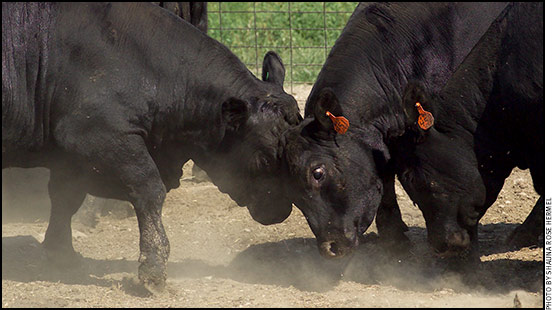
The main things to think about when transitioning bulls to the breeding pasture are body condition, exercise and general level of fitness, and making sure vaccinations and parasite control are up to date. Keep in mind that a pecking order will be established.
Transition from Feeding to Breeding
Tips offered on transitioning a bull from a presale feeding ration to being ready to work.
Many bulls purchased at a bull sale have been overfed to some degree and confined during their growing months. Now, they must suddenly adjust to being on pasture and breeding cows. Most of them need a little time to make the transition.
“The first step is to avoid buying a bull that is grossly overfat,” says John Kastelic, veterinarian and professor of cattle reproductive health at the University of Calgary. “He needs to be in reasonable condition, however, since bulls lose a lot of weight during their first breeding season, especially on extensive range pastures. If they are fairly active, they will easily drop 200 pounds or more. You don’t want them going out thin, especially if they are breeding cows early in the spring. That early grass looks lush and green, but has high water content and not enough dry matter,” he says.
You want the bull not too thin and not too fat, and on a mostly forage-based diet before you turn them out. It’s also wise to have bulls in a large enough area to get some exercise. Otherwise they are like the human couch potato who is out of shape.
“Producers often winter bulls in small pens with robust fences, and then turn them out with cows into big pastures, which is a huge transition. They are better off in a larger lot where they have to walk from feed to water. All too often the producer brings home an expensive bull and puts him in a small pen to protect him from injury, and when he goes out to work, he is not ready for it,” says Kastelic. “Bulls are hard on fences, so people often have a small, secure bull pen.”
The main things to think about when transitioning bulls to the breeding pasture are body condition, exercise and general level of fitness, and making sure vaccinations and parasite control are up to date.
There are advantages to bringing the bull home a few weeks or months before breeding season, rather than having the breeder keep and feed him for later delivery. If the bull has a chance to adjust to your own environment, he’ll usually do better than if he’s dropped off at the breeding pasture a few days before turnout.
“From a biosecurity perspective, you should be bringing him home and have him isolated for a few weeks or a month, and give him time to transition,” Kastelic says.
“Inevitably, when you transport a bull, there will be some stress. When you stress a bull, you suppress the luteinizing hormone and it drops, taking testosterone down with it. With relocation there will always be some stress and decrease in semen quality. How long the decrease in semen quality persists will depend on how anxious the bull is, how long the trip is, etc.,” Kastelic adds.
If a yearling bull is brought to a new farm and is put in a pen with mature bulls, he could get beaten up and have some issues with semen quality for six weeks or more. With any kind of stress, Kastelic says abnormal sperm shows up in about 10 days, and it may take three to six weeks for semen to get back to normal, depending on how stressed he was and how severe the changes are.
The new bull needs plenty of time for biosecurity issues and some additional time for the transition to play out.
Some ranchers like to get their new bulls in the fall and have them adjusted to the new environment and the pecking order within a group of bulls before they are all turned out in the same breeding pasture the next spring.

Editor’s Note: Heather Smith Thomas is a cattlewoman and freelance writer from Salmon, Idaho.






